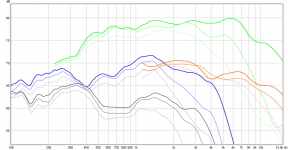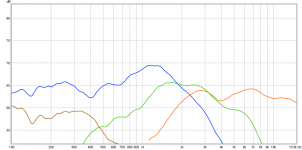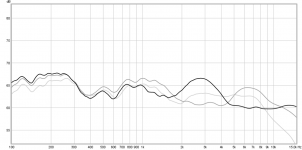But who here uses 2-way speakers? Most of us use 3-ways or 4-ways. Yes, if you're alternatively using powered subs I don't know how you can make the claim that your system is "passive".
Speak for yourself... almost all my speakers are 1-way. Sometimes with an active sub-100 Hz woofer. When i do a 2-way, XO is typically 150-350 Hz. The last one i did was passive. 2 parts (if you exclude the bypass on the cap) in the XO. The one before was active (6Rs, 6Cs in the PLLXO) because the woofer wasn't efficient enuff. BSC designed into the speaker itself (both cases). Next one will be active (5 driver 2 way, woofers too efficient) with PureVinyl (i hope) doing the XO digitally.
dave
Can't remember ever hearing a 300dB/octave crossover (maybe at a show) but I just heard a very nice speaker that used lots of overlap in it's passive filters. Not my approach, but it sure did sound good.
Overlap can be good or bad. I just want to clarify that i'm not saying a 300db/octave is the cure to all the problems in the world. Some of the finer speakers out there use a 2nd order slope and the result is a difficult to notice driver integration.
I was just making the case that if a person has the money, it'd definitely be something to consider, rather than futon on the ground and ugly diffusion panel on the ceiling to ""solve"" this issue. - that there's a lot more transfer functions available actively than there is passively. What a person's subjective preferences leads them to prefer is their choice, but it's ::not:: a choice if you're restricted to a passive XO, and it's also not a valid comparision if you're going with an active transfer function specifically designed to mimic what you did passively, because you've got more flexibility than that.
Last edited:
Passive is a remnant of old technology days when amps were expensive - active, digital crossovers are the future. Inductors have copper losses if air-cored and distortion if ferrite cored. Capacitors are bulky and expensive if non-polar, subject to ageing and distortion if liquid electrolyte. What's not to love about active? Active sounds better owing to lower distortion and lower losses, greater stability of values and more degrees of freedom in design.
I still think its a good deal at around $300, I've spent more than that on a single driver that hasn't been anything like as good value.
What does the 96k miniDSP cost once you add PS, case, and all the plug-ins you need?
dave
Active sounds better owing to lower distortion
But a typical active XO will have more unnatural higher order distortion compenents, that don't need to be very high to get in the way, giving the whole works an electonic edge. One has to be very careful to make an XO that is transparent.
dave
But a typical active XO will have more unnatural higher order distortion compenents, that don't need to be very high to get in the way, giving the whole works an electonic edge.
Yeah I wasn't talking about typical implementations, I agree with you here. Typically actives suck, but that's an implementation issue, not fundamental to the debate.
One has to be very careful to make an XO that is transparent.
Absolutely, that's part of the fun of actives for me.
You can bi or tri-amp with passive too, you know.
Even more of a folly, if you ask me.
Hmmm something I didn't consider when I was trying to get rid of my impedance dip to 2 ohms. I could get a really flat (simulated) spl curve but only with a nasty dip to a bit under 2 ohms at 2Khz. If the mid and tweet circuits were being driven by different amps then that problem would have gone away.
I actually suspect that in some cases response shaping (dsp's excluded?) may be easier with passives than with actives.
Tony.
Typically actives suck, but that's an implementation issue, not fundamental to the debate.
Agreed. But someone's expressed opinions may well be based soley on exemplars from the 1st mentioned subset
dave
Agreed. But someone's expressed opinions may well be based soley on exemplars from the 1st mentioned subset
Indeed - actives have gotten a bad rap because in many (most?) the electronics are suboptimally designed. But that's not an argument against actives, just an argument against poor design
On the other hand you can build a passive crossover out of low cost components and again you'll most likely spend less than the $100 the miniDSP costs...
That's comparing components with sub-systems, not entirely apples-apples. Implementing the digital active with modern DSP-capable MCUs (as components rather than boards) I reckon would approach price parity when acoustic output is the normalising parameter. That's because the considerable losses in passive XOs have the price of additional watts in amplifier power.
This is just the topic that I needed to see and read.
I was going to try to optimize or replace the passive crossovers in an old (1974) ScanSpeak 3.5 way system, but I think I'll try the active route instead. As a DIYer with little design experience, the project was getting to be too much of a struggle... I downloaded PCDesigner, but my PC then became tangled in issues with Excel and its Macros. On top of that my PC firewall, ZoneAlarm, thinks that zma files are actually something else (and something dangerous), so it locks them from opening.
Add to this a system that needs 10+db of midrange padding and has a 1st order (I think) series crossover that has three drivers merging and overlapping from 1.8 - 4.0 khz.
Individual drivers at 0-30-60 (dark to light)
orange=tweeter / green=mid / blue=woofer / brown= helper woofer

Individual drivers measured via the series crossover

Total system at 0-30-60
It's a wild ride between between 2 and 8 khz !

A good candidate for active, no?
I was going to try to optimize or replace the passive crossovers in an old (1974) ScanSpeak 3.5 way system, but I think I'll try the active route instead. As a DIYer with little design experience, the project was getting to be too much of a struggle... I downloaded PCDesigner, but my PC then became tangled in issues with Excel and its Macros. On top of that my PC firewall, ZoneAlarm, thinks that zma files are actually something else (and something dangerous), so it locks them from opening.
Add to this a system that needs 10+db of midrange padding and has a 1st order (I think) series crossover that has three drivers merging and overlapping from 1.8 - 4.0 khz.
Individual drivers at 0-30-60 (dark to light)
orange=tweeter / green=mid / blue=woofer / brown= helper woofer

Individual drivers measured via the series crossover

Total system at 0-30-60
It's a wild ride between between 2 and 8 khz !

A good candidate for active, no?
Last edited:
I actually suspect that in some cases response shaping (dsp's excluded?) may be easier with passives than with actives.
Let's try an experiment. I'll put together a cap, an inductor and a resistor. You breadboard an op-amp, build it a dual supply, design a notch filtering feedback loop and ensure its stability. Then while we tune them, see how long between listening tests for each kind.
Then while we tune them, see how long between listening tests for each kind.
Ah - there's the beauty of digital (in theory I hasten to add here - I'm not aware of anyone who's actually implemented this yet). No stopping the listening process at all, seamless remote adjustment while listening continues unabated.
Yes, that is a good thing. I've considered using DSP for prototyping after which I'd convert all my hard work into something more tangible.
What's with this statement?
What's with this statement?
You have me thinking of scrapping the air variables in my next tuner project. Varactors have so much more to offer.Passive is a remnant of old technology days when amps were expensive
What's with this statement?
You're asking me a question? If you think citing an example where older technology is still better than new (as I take varactors vs air variables to be, however this is just a wild guess) contradicts my point then you've misunderstood. If you'd like to understand further then ask a clarifying question so I can hope to pinpoint your misunderstanding.
Active all the way here. I see little compelling argument for passive at all except in some cases for cost, and in sometimes there the difference is not all that much especially when you factor in shipping and other incidental costs for those of us not in the US.
All of the best speakers I've heard in years have been active.
All of the best speakers I've heard in years have been active.
I thought a more broad and conclusive argument would be needed to complement such an assertion.
I'd be happy to offer more support for my assertion - the way to get that would be to ask some provocative or stimulating question to evoke dialogue
A flat amplitude response with uniform group delay.Which could be true, but what purpose would that be?
You can jog up and down a dead end street and you end up at the same spot.Do you think Zaph and Earl and every other competent loudspeaker manufacturer/designer go through tens of hundreds of iterations because their simulations don't match up to the real world?
What, no provision for the outhouse?kitchen and bedrooms get passive crossovers though, why? Because they are better suited.

- Status
- This old topic is closed. If you want to reopen this topic, contact a moderator using the "Report Post" button.
- Home
- Loudspeakers
- Multi-Way
- What do you think of passive crossovers?